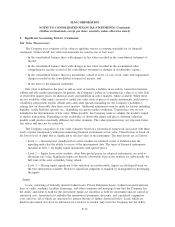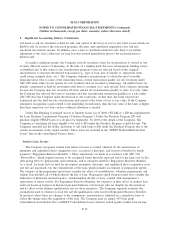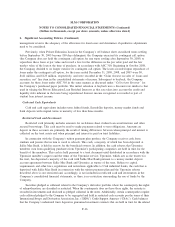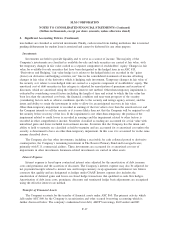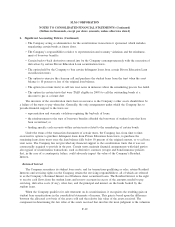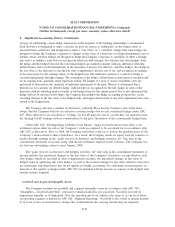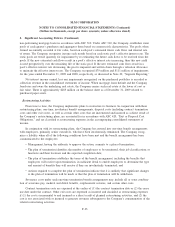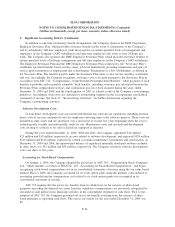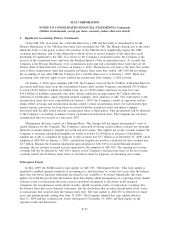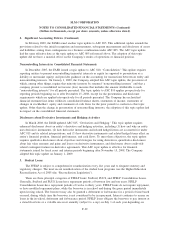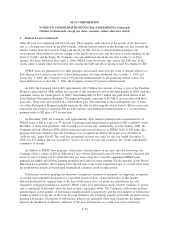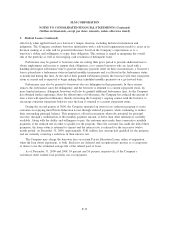Sallie Mae 2009 Annual Report Download - page 148
Download and view the complete annual report
Please find page 148 of the 2009 Sallie Mae annual report below. You can navigate through the pages in the report by either clicking on the pages listed below, or by using the keyword search tool below to find specific information within the annual report.2. Significant Accounting Policies (Continued)
strategy for undertaking various hedge transactions at the inception of the hedging relationship, is documented.
Each derivative is designated to either a specific (or pool of) asset(s) or liability(ies) on the balance sheet or
expected future cash flows, and designated as either a “fair value” or a “cash flow” hedge. Fair value hedges are
designed to hedge the Company’s exposure to changes in fair value of a fixed rate or foreign denominated asset or
liability, while cash flow hedges are designed to hedge the Company’s exposure to variability of either a floating
rate asset’s or liability’s cash flows or an expected fixed rate debt issuance. For effective fair value hedges, both
the hedge and the hedged item (for the risk being hedged) are marked-to-market with any difference reflecting
ineffectiveness and recorded immediately in the statement of income. For effective cash flow hedges, the change in
the fair value of the derivative is recorded in other comprehensive income, net of tax, and recognized in earnings
in the same period as the earnings effects of the hedged item. The ineffective portion of a cash flow hedge is
recorded immediately through earnings. The assessment of the hedge’s effectiveness is performed at inception and
on an ongoing basis, generally using regression testing. For hedges of a pool of assets or liabilities, tests are
performed to demonstrate the similarity of individual instruments of the pool. When it is determined that a
derivative is not currently an effective hedge, ineffectiveness is recognized for the full change in value of the
derivative with no offsetting mark-to-market of the hedged item for the current period. If it is also determined the
hedge will not be effective in the future, the Company discontinues the hedge accounting prospectively, ceases
recording changes in the fair value of the hedged item, and begins amortization of any basis adjustments that exist
related to the hedged item.
The Company also has a number of derivatives, primarily Floor Income Contracts and certain basis
swaps, that the Company believes are effective economic hedges but are not considered hedges under ASC
815. These derivatives are classified as “trading” for GAAP purposes and as a result they are marked-to-mar-
ket through GAAP earnings with no consideration for the price fluctuation of the economically hedged item.
Under ASC 450, “Distinguishing Liabilities from Equity,” equity forward contracts that allow a net
settlement option either in cash or the Company’s stock are required to be accounted for in accordance with
ASC 815 as derivatives. Prior to 2008, the Company used these contracts to lock-in the purchase price of the
Company’s stock related to share repurchases. As a result, the Company marks its equity forward contracts to
market through earnings in the “gains (losses) on derivative and hedging activities, net” line item in the
consolidated statements of income along with the net settlement expense on the contracts. The Company has
not had any outstanding contracts since January 2008.
The “gains (losses) on derivative and hedging activities, net” line item in the consolidated statements of
income includes the unrealized changes in the fair value of the Company’s derivatives (except effective cash
flow hedges which are recorded in other comprehensive income), the unrealized changes in fair value of
hedged items in qualifying fair value hedges, as well as the realized changes in fair value related to derivative
net settlements and dispositions that do not qualify for hedge accounting. Net settlement income/expense on
derivatives that qualify as hedges under ASC 815 are included with the income or expense of the hedged item
(mainly interest expense).
Goodwill and Acquired Intangible Assets
The Company accounts for goodwill and acquired intangible assets in accordance with ASC 350,
“Intangibles—Goodwill and Other,” pursuant to which goodwill is not amortized. Goodwill is tested for
impairment annually as of September 30 at the reporting unit level, which is the same as or one level below
an operating segment as defined in ASC 280, “Segment Reporting.” Goodwill is also tested at interim periods
if an event occurs or circumstances change that would indicate the carrying amount may be impaired.
F-21
SLM CORPORATION
NOTES TO CONSOLIDATED FINANCIAL STATEMENTS (Continued)
(Dollars in thousands, except per share amounts, unless otherwise stated)



